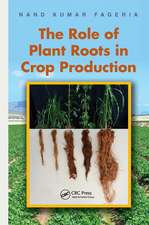Alkaloid Biology and Metabolism in Plants
Autor G. Walleren Limba Engleză Paperback – 19 feb 2012
Preț: 640.55 lei
Preț vechi: 753.60 lei
-15% Nou
Puncte Express: 961
Preț estimativ în valută:
122.57€ • 133.56$ • 103.28£
122.57€ • 133.56$ • 103.28£
Carte tipărită la comandă
Livrare economică 24 aprilie-08 mai
Preluare comenzi: 021 569.72.76
Specificații
ISBN-13: 9781468407747
ISBN-10: 1468407740
Pagini: 316
Ilustrații: XVIII, 294 p.
Dimensiuni: 152 x 229 x 17 mm
Greutate: 0.42 kg
Ediția:Softcover reprint of the original 1st ed. 1978
Editura: Springer Us
Colecția Springer
Locul publicării:New York, NY, United States
ISBN-10: 1468407740
Pagini: 316
Ilustrații: XVIII, 294 p.
Dimensiuni: 152 x 229 x 17 mm
Greutate: 0.42 kg
Ediția:Softcover reprint of the original 1st ed. 1978
Editura: Springer Us
Colecția Springer
Locul publicării:New York, NY, United States
Public țintă
ResearchCuprins
1. Alkaloids in Chemotaxonomic Relationships.- 1.1. Introduction.- 1.2. Taxonomic Character of Alkaloids.- 1.3. Conclusion.- 2. Genetic Control of Alkaloid Production.- 2.1. One Gene, One Enzyme, One Reaction Hypothesis.- 2.2. Alkaloid-Rich and Alkaloid-Poor Plants within a Species: The Inheritance Pattern.- 2.3. The Inheritance Patterns of Individual Alkaloids.- 2.4. Intraspecific and Interspecific Hybridization.- 2.5. The Inheritance of Ability to Store Alkaloids of Different Oxidation Levels.- 2.6. Inheritance of the Ability to Store O-Methylated Alkaloids.- 2.7. Inheritance Pattern for Nitrogen Methylation.- 2.8. Inheritance Patterns Related to the Complexity of the Molecular Formula.- 2.9. Conclusions.- 3. Environmental Influences on Alkaloid Production.- 3.1. Introduction.- 3.2. The Influence of Light, Water, and General Climatic Conditions.- 3.3. Nitrogen, Potassium, and Other Mineral Nutrients.- 3.4. External Influences.- 3.5. Conclusion.- 4. Sites of Alkaloid Formation.- 4.1. Introduction.- 4.2. Solanaceae Alkaloids.- 4.3. Lupine Alkaloids..- 4.4. Papaveraceae Alkaloids.- 4.5. Ricinine in Ricinus communis.- 4.6. Other Plants.- 4.7. Alkaloid Accumulation in Seeds.- 4.8. Conclusions.- 5. The Role of Alkaloids in Plants.- 5.1. Introduction.- 5.2. Alkaloids as Growth Stimulators and Inhibitors.- 5.3. Alkaloids as Plant-Protecting Compounds.- 5.4. Protection against Fungi and Bacteria.- 5.5. Alkaloids and Virus Resistance.- 5.6. Plant-Insect Coevolution: The Role of Alkaloids.- 5.7. Alkaloids and Herbivorous Vertebrates.- 5.8. Other Roles of Alkaloids.- 5.9. Conclusion.- 6. Metabolic (Catabolic) Modifications of Alkaloids by Plants.- 6.1. Introduction.- 6.2. Methods Used to Study Secondary Metabolism of Alkaloids.- 6.3. Evidence for Metabolism or Catabolism.- 6.4. Diurnal and Developmental Variations.- 6.5. Turnover Rates.- 6.6. Demethylation.- 6.7. More Extensive Degradation of Alkaloids and Introduction of Their Catabolites into Primary Metabolic Pathways.- 6.8. Subcellular Localization of Alkaloids.- 6.9. Bound Forms of Alkaloids.- 6.10. Regulation of Metabolic Pathways.- 6.11. Use of the Metabolic Grid to Explain the Metabolism of Ricinine in Ricinus communis and Quinolizidine Alkaloids in Leguminosae.- 6.12. Summary.- References.- Author Index.











